environmental benefit of wastewater treatment plants in mountainous areas in the alps

|
Comparison of technology, costs and environmental benefit of wastewater treatment plants in mountainous areas in the alps |

|
Abstract
Keywords
Introduction
Sites and methods
Results and discussion
Conclusions
Acknowledgement
References
The Commission of the European Communities (CEC) is just working out a new directive in order to regulate the agricultural reuse of sewage sludge. This new regulation will also effect a “special case” – sludge usage in a mountainous environment – which will be discussed in this paper. Three reuse sites at small wastewater treatment plants of mountain refuges at altitudes more than 2000 m a.s.l. are investigated. Applied sludge, soil and drainageflow from lysimeters are analysed. Concerning heavy metal concentrations domestic sewage sludge from these sites differs significantly from municipal sludge. A comparison with background concentrations reveals that no relevant accumulative pollution of the soil is possible. An increase of coliform bacteria of maximum two orders of magnitude is preserved during the long winter period and indicates a limited hygienic risk.
Sewage sludge, sludge management regulations, sludge usage, heavy metals, small wastewater treatment plant
The 3rd draft of the working document (CEC, 2000) intends a significant reduction of maximum metal levels for sludge and soil (in comparison with the valid Directive 86/278/EEC). Additionally appropriate sludge treatment strategies for desinfection and stabilisation are listed and the requirements for analysis, sampling and sampling frequency are stated. The referenced sludge management regulation defines clear responsibilities of sludge producers and receivers and aims on the control of an environmental save and economical reasonable sludge application on soils. To achieve these goals within maintainable control efforts a minimum sludge turn over on both sides producer and receiver is required. Hence sludge from small wastewater treatment plants (WWTPs) should be treated in joint facilities and according to the 3rd draft of the CEC directive “sludge from septic tanks and similar installations should be taken to a WWTP for further treatment.” A derogation from this requirement on a case-by-case basis is suggested for long transport distances - a condition definitely true for remote tourist facilities in mountainous regions.The use of sludge on soils can induce three impacts on the environment distinguishing gaseous, liquid and solid phase:
Concerning impacts on the vegetation mountain regions completely differ from reclaimed land where fertilization is the most welcome consequence of the use of sludge on soils. In extreme alpine environments sludge use deviates from any agricultural meaning. On the contrary a nutrient input causes an unwanted displacement of environment specific plant species on the affected area which is a significant issue in national parks. This paper does not aim on the influences on the nutrient budget of alpine soils but reflects the potential of trace metal accumulation in the soil and in percolating water and also hygienic aspects – that are the main issues sludge management regulations deal with.
- impacts on the soil composition by the input of compounds enriched in the sludge (potentially toxic elements like heavy metals; pathogens and parasites; nutrients)
- impacts on the percolating water and consequently on the groundwater quality by mobilisation of compounds accumulated in the soil
- impacts on the neighbouring atmosphere by eventual problems of odour nuisance
This study considers the impacts of sewage sludge usage at 3 refuges of the German Alpine Association (DAV) in the Austrian Alps. Berlin refuge (2044 m a.s.l.), Taschach refuge (2434 m a.s.l.) and Stuttgart refuge (2310 m a.s.l.) are equipped with biological wastewater treatment (3 different cyclic activated sludge systems with maximum organic loads of 150 to 260 p.e.) but are not available by roads. The mechanical wastewater treatment is performed in septic tanks which serve both as primary clarifiers and as sludge storage units. All 3 facilities are run only during the 3 months summer season. After the season stored primary and secondary sludge is spread on the soil at the sites. The settled sludge amounts to 8 to 18 m3 per season with 1.5 to 2 % dry matter (Tab.1) which represents organic loads of 200 to 400 kg COD.Samples of used sludge, amended and unamended soil and drainage water have been taken. At each investigated site the monitoring equipment was installed twice, one in the area of sludge usage and the reference measurement in an unaffected area. Percolating water collectors of 1 m2 size have been installed beneath about 30 cm humus topsoil overlaying mainly massive rock (Plank, 2001). The percolating water from the lysimeter was led to a sampling tank with a volume of 200 litre. The monitored area was fenced in and an ombrometer was installed. The sampling interval was about one month which means 3 samples a season. The monitoring period is still proceeding. Trace metals have been analysed according to ISO 11885 standard and hygienic parameters according to ISO 9308/1, 9308/3, 7899/2 and 6222.
dry matter loss of ignit. org. portion COD N total P total pH
SS [%] LI [%] g COD / g SS g COD / l mg N / l mg P / l Berlin refuge 1,5 87 1,33 20,0 503 148 6,1 Stuttgart refuge 1,7 87 1,73 28,9 482 35 6,5 Taschach refuge 1,9 95 1,40 27,2 291 26 6,0 Tab.1: Measured sludge parameters at the 3 investigated sites
Heavy Metals
Characteristic heavy metal concentrations in treated sludge from municipal wastewater treatment plants (ATV, 1996) are far from the regulation limits if there is no major industrial influence (Fig.1). Plumbery materials like zinc and copper are close to a half respectively a third of the standards in average. Sewage sludge of the investigated small WWTPs of tourist facilities in the mountains show similar concentration distributions but on a much lower level which corresponds with former studies on sewage sludge composts at refuges (Rauch et al., 1999; Vestner et al., 1999).
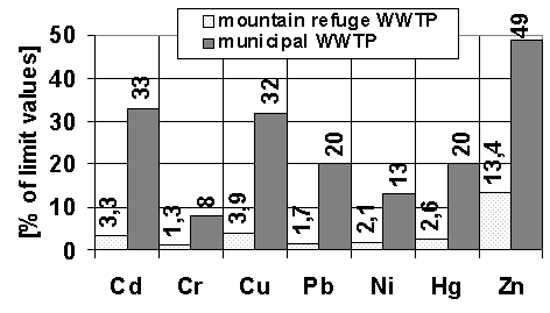
|
Fig. 1: Metal concentrations in typical municipal sewage sludge (ATV 1996) and average values of the 3 investigated sites in comparison with the limit values of the proposed CEC directive (concentration limits: Cd 10, Cr 1000, Cu 1000, Pb 750, Ni 300, Hg 10, Zn 2500 mg/kg dm) |
A high initial organic content of the sludge spread on the land will be biologically degraded and a equilibration process will result in a homogenous mass of soil. During this stabilisation process weakly adsorbed and organically bound metals get mobilised and are transported from the surface into the humus layer towards a more stabile chemical complex. Planquart et al. (1999) applied selective sequential extraction procedures (Tessier et al., 1979) to study metal speciations in soil and sludge. They found up to 60 % Zn in easily mobilizable forms in partly stabilised sludges and only 24 % in a sludge which had undergone a more advanced humification process. In fig.2 trace metals in used unstabilised sludges of the three investigated sites are related to the same organic content as of the amended soils. The mean content of organic matter was 89 % of solid sludge in comparison with 54 % organic matter of total dry weight of soil. Hence measured metal concentration in the sludges have been multiplied by the factor 3.6. Jenn-Hung Hsu (2001) measured a 2.7 fold increase of metal concentration during composting due to decomposition of organic matter. With the exception of Zn and Cu metal concentrations in the applied sludges are in the same range as in the soil and therefore no metal accumulation is possible.
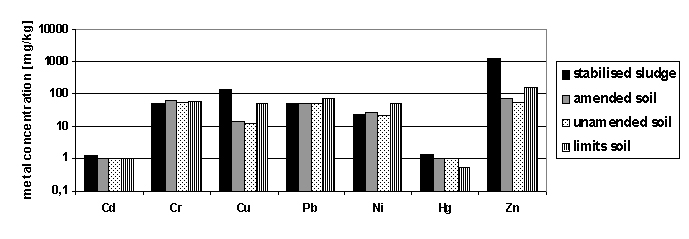
|
Fig. 2: Average metal concentrations of used sludges at the investigated sites related to the same organic content as of the amended soil in comparison with soil and proposed CEC limits for soil (concentration limits: Cd 1, Cr 60, Cu 50, Pb 70, Ni 50, Hg 0.2, Zn 150 mg/kg dm). |
About 200 l/m2 of leachate was collected per month on each site with mean concentrations of 0.036 mg Zn/l and 0.005 mg Cu/l (2 to 3 orders of magnitude below limit values for drinking water). Assuming constant percolation about 0.03 mg mobile Cu/m2 on the average is drained every day – a value below copper depositions detected at the nearest air pollution control station.
Hygienic aspects
The used sludge is hardly stabilised after a mean anaerobic retention time of almost 2 months at low temperatures around 10 °C. Without advanced sludge treatment – neither dewatering nor stabilisation nor desinfection – the sludge is pumped out on the alpine grassland at the sites. That means high initial concentrations of fecal organisms: The total coliforms in the sludge amount to 1E+05 cfu/ml, E.coli to 1E+04, enterococci to 1E+04 and at one site salmonella was detected. The monitoring did not focus on the period immediately after the sludge application but on the succeeding summer season after an almost 7 months winter period.Despite long preserving frost conditions the population of the common indicator bacteria E. coli is not expected to survive to the following summer season. Ogden et al. (2001) observed a maximum half-life of the die off of 24 days for E.coli after a cattle slurry application in Scotland: After a 4-weeks period less than 100 cfu / g soil remained. At the 3 studied sites in this paper both E. coli and enterococci in the soil were < 100 cfu / g at the beginning of the summer season. The number of total bacteria in the soil at the reuse sites and at the unaffected areas showed no significant difference (Fig.3). Although not all coliform bacteria are of obligatory fecal origin this parameter is still a common fecal indicator (Gauthier et al., 2001). Actually the soil at the reuse sites showed an increased population of coliform bacteria in comparison with the unaffected soil (Fig.3). Note that the number of bacteria in the applied sludge are related to ml water volume while soil bacteria are related to mass with much less water content.
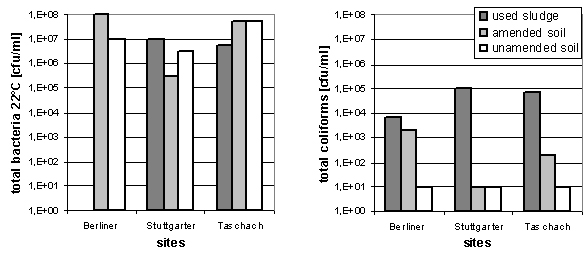
Concerning the percolating water from the reuse sites the abundance of explicit fecal indicators shows the same pattern as in the soil. Ogden et al. (2001) measured a significant pollution of drainage water immediately after application of slurry with leaching losses between 0.2 % and 10 % depending on rainfall. At the 3 investigated sites at the beginning of the summer season E. coli and enterococci were less than 100 cfu / ml water. Fig.4 shows the decrease of total bacteria and of total coliforms in the drainflow during the season. For both parameters the sludge application induces higher concentrations than the background values, still no extreme hazard for a contamination of drinking water can be derived from this fact.
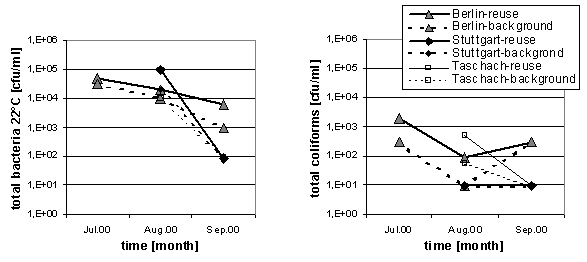
Increased coliform bacteria concentrations at the reuse side raise the question how to improve the situation. Being aware of the low amount of sludge produced at these facilities and the extreme location only simple and cheap technologies are applicable. Sludge composting could offer a solution but low temperatures, lack of energy and lack of available maintenance set the limits. A precondition for composting is sufficient dewatering of sludge or immediate particle separation of fresh raw wastewater. Special equipment was developed for this field of application. For example lanes of filter-bags can separate 40 % of the organic load from the wastewater flow without any energy demand (Ingerle et al., 1986) or mechanical sieves have also been applied. Fig.5 shows the reduction of fecal bacteria in filter-bag material stored outdoors under a humus layer (Breslau refuge) and of sieve material stored in a solar heated room (Ramol refuge). Both methods represent long-term processes in order to achieve satisfying reduction rates.
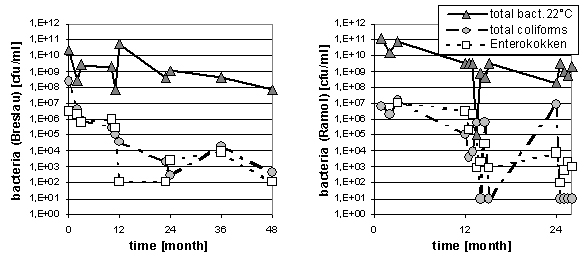
Trace metals in sludge, soil and leachate compared with corresponding limit values indicate that it is justified to use the consumer friendly synonym “biosolids” instead of “sewage sludge” at small WWTPs in mountain regions. Measured trace metal concentrations in the sludge are in the range of background concentrations in the unamended soil. Heavy metal concentrations in the percolating water in most cases are below the standard detection limits. In this field a case-by-case regulation by authorities as suggested by the CEC working paper should be considered in order to prevent excessive control measures or outlawing of the owners of these sites. Increased concentrations of fecal bacteria in the soil and the percolating water at the reuse sites point on a potential hygienic hazard. Since sludge composting obtains only a slow improvement of hygienical parameters a chemical desinfection by liming could offer an alternative solution which needs further discussion.
The results of this presentation are achieved within the project „Comparison of technology, costs and environmental benefit of wastewater treatment plants in mountainous areas in the Alps“, which is supported by the LIFE-program of the European Commission.
ATV (German Wastewater Technology Association), 1996: ATV-handbook "Sewage Sludge" (in German). Ernst & Sohn, 4th editionCommission of the European Communities, 2000: Working document on sludge. 3rd draft, Brussels
Gauthier, F. and Archibald, F. 2001: The ecology of “fecal indicator” bacteria commonly found in pulp and paper mill water systems. Wat.Res., 35, 2207-2218
Ingerle, K. and Stegner, U. 1986: The filter-bag system (in German). Oesterreichische Wasserwirtschaft, 38, 1/2
Jenn-Hung Hsu, Shang-Lien Lo 2001: Effect of composting on characterization and leaching of copper, manganese and zinc from swine manure. Environm. Pollution, 114, 119-127
Ogden, I.D.; Fenlon, D.R.; Vinten, A.J.A.; Lewis, D. 2001: The fate of Escherichia coli O157 in soil and its potential to contaminate drinking water. Int. Journal of Food Microbiol., 66, 111-117
ÖWAV (Austrian Water and Waste Management Association), 2000: Wastewater treatment in mountainous areas (in German, English, French and Italian). Guideline 1, Vienna
Plank, M., 2001: Sewage sludge disposal in mountain regions (in German). MSc thesis, Inst. Environmental Engineering, Univ. Innsbruck
Planquart, P., Bonin, G., Prone, A., Massiani, C., 1999: Distribution, movement and plant availability of trace metals in soils amended with sewage sludge compost: application to low metal loading.
The Science of the Total Environment, 241, 161-179. Rauch, W. and Becker, W. 1999: Waste sludge disposal in extreme alpine environments. Waste Management & Research, 16, 1-8
Scancar, J., Milacic, R., Strazar, M., Burica, O., Bukovec, P. 2001: Environmentally safe sewage sludge disposal: The impact of liming on the behaviour of Cd, Cr, Cu, Fe, Mn, Ni, Pb and Zn. J. of Environm. Monitoring, 3/2, 226-231
Tessier, A., Campbell, P., Bisson, M.1979: Sequential extraction procedure for the speciation of particulate trace metals. Anal. Chem., 51, 844-851
Vestner, R.J. and Günthert, W.F., 1999: Wastewater management in alpine regions (in German). Korrespondenz Abwasser, 46/9, 1390-1400